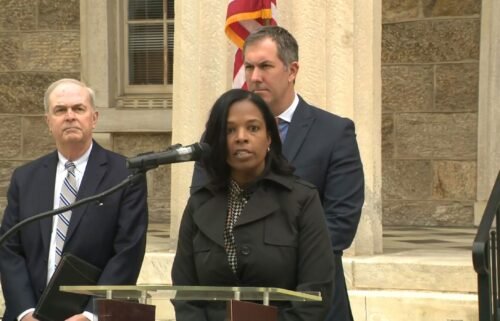Why Ida’s remnants were so deadly for the Northeast

By Christina Maxouris, CNN
As the US watched Hurricane Ida barrel its way toward Louisiana’s coast last month, state officials had already sounded the alarm.
New Orleans Mayor LaToya Cantrell was imploring residents to leave. Other towns issued mandatory evacuations. Thousands of soldiers and airmen from the state’s National Guard had been mobilized. Louisiana Gov. John Bel Edwards was predicting the storm would be among the strongest hurricanes to hit the state in more than a century.
The storm made landfall near Port Fourchon on August 29 as a Category 4 hurricane, before eventually weakening to a tropical depression. Its hit was deadly — claiming the lives of at least 26 people across Louisiana and two in Mississippi, destroying businesses and neighborhoods and knocking out power to hundreds of thousands.
Yet the storm spared the Gulf states the kind of death toll officials feared they’d face on the 16th anniversary of Hurricane Katrina.
Instead, it continued trekking inland, making its way to the Northeast, where it delivered another round of misery, flooding streets, homes and neighborhoods and blindsiding local and state leaders who scrambled to respond to the storm’s fierce second punch. At least 52 people died across New York, New Jersey, Connecticut, Maryland, Pennsylvania and Virginia.
“New York City literally has been paralyzed,” New York Gov. Kathy Hochul told CNN last week. “Unprecedented is almost an understatement. This is the first time ever we’ve had a flash flood emergency declared.”
The storm’s remnants dumped stunning amounts of rain across the East Coast. But it wasn’t just the downpour that made the Ida’s aftermath so deadly. Experts say there were several factors that compounded and led to the devastation and high death toll.
People tend to underestimate flood warnings
When meteorologists accurately forecast the storm’s hit on Louisiana, many people in the state — by now used to similar severe weather phenomena — heeded the warnings.
The grim predictions, which came several days in advance, gave residents in the state’s most vulnerable communities — including areas outside Louisiana’s flood protection system — time to evacuate and seek higher ground.
Meteorologists similarly knew what was coming for the Northeast — and warned about the potential for major flooding.
But in severe weather events, it’s usually the threat of winds — not water — that pushes people to flee, CNN meteorologist Taylor Ward said.
“This is despite the fact that water is the number one killer in a hurricane — not winds,” Ward said. “In general, large numbers of people don’t evacuate from flash flooding. It could be that people have more fear or a hurricane than a flood, or believe they are more used to be being in flood watches and don’t need to leave.”
But following the storm’s relentless, deadly flooding, New York City Mayor Bill de Blasio called Ida a “wake-up call.”
He said last week the extreme rainfall should make everyone rethink expectations for evacuations, saying he would also consider being more aggressive with pre-storm evacuations and orders to clear the streets and subways in the future. Those steps would usually be reserved for hurricanes or massive blizzards.
“We’re going to have to be much more aggressive with these tools,” de Blasio told CNN.
Labels matter
It also didn’t help that, as Ida was making its way through the US, the message many Americans heard was that it was no longer a hurricane — but rather the remnants of the storm it once was.
“It’s so hard to convey the threat of the remnants of a hurricane,” Dr. Craig Colten, professor emeritus of geography at Louisiana State University, told CNN. “We tend to really diminish the threat. But some of the worst flooding in recent decades has been inland flooding, or flooding from remnant storms.”
When storms are downgraded, people tend to relax and don’t pay as close attention, Colten said, which can make it difficult for officials to convey the dangers of approaching severe weather and convince residents that they should evacuate or take certain precautions.
“It’s hard to capture people’s attention in the same way when you’re talking about the remnants of a (storm). It’s now just a tropical depression, it’s no longer a hurricane. People aren’t going to leave a ground-level apartment.”
Since the amount of rain and flooding that parts of the Northeast saw was largely unprecedented, many people didn’t understand or underestimated what its effects would be, said Ward.
Infrastructure plays a critical role
Places like New York City are also not built to handle that kind of water.
“There are very few basements in Louisiana, very few people live below, or even have a part of their house below the land surface,” Colten said. “Architecture and the local high water table — which makes people not want to build basements and the fact that simply most houses are elevated, even with the same kind of rapid flooding that happened in New York, if that had occurred in Louisiana, you wouldn’t have seen the fatalities.”
In New York City, most of the homes where residents were found dead were illegally converted basement or cellar apartments, officials have said. Those spaces often lack adequate means of escape in times of emergency — and in many cases may not have windows or only have one way to go in or out.
De Blasio said Tuesday there are at least 50,000 illegal basement apartments across the city, with a total of at least 100,000 people living in them.
Colten said climate change means that severe weather events like the one that unfolded last week in the Northeast will continue to happen, and government leaders will have to adapt their current practices in order to ensure the public’s safety. “We need to make sure these illegal basement apartments are made safe,” he said.
Heavy rain came over a densely populated area
But it’s not just the infrastructure that didn’t help. The heavy rain came down — quickly — on one of the most densely populated areas in the US, which experts say also factored into the high death toll following the storm.
“The fact you had those extreme rain rates that aligned over that densely populated area is why it unfolded the way it did,” Alex Lamers, a meteorologist at the Weather Prediction Center, previously told CNN.
The storm dumped an average of 7 inches of rain across the five boroughs of New York City — meaning the city saw more than 35 billion gallons of water fall from the sky in about a six-hour period last Wednesday. On the same day, Newark, New Jersey — the state’s most populous city — recorded its rainiest day on record, with more than 8 inches of rain recorded.
“The number of people and population density factored in hugely,” Colten said. “You’ve got 8 million plus people in New York City alone. Louisiana has four-and-a-half million people statewide, maybe a million in the exposed area. So, far fewer people were exposed to damage here.”
That’s also why evacuating places like New York City would be so much harder, he added.
In New Jersey, Gov. Phil Murphy said that while victims of the storm were spread across a handful of counties, deaths were “largely concentrated” in central Jersey.
The-CNN-Wire
™ & © 2021 Cable News Network, Inc., a WarnerMedia Company. All rights reserved.



